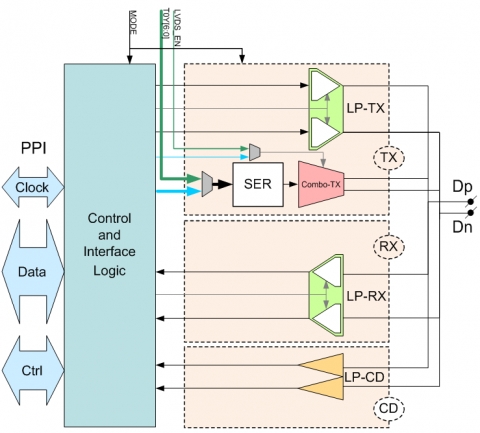You are here:

MIPI D-PHY/LVDS Combo TX (Transmitter) for Automotive in Samsung 28FDSOI
The MXL-LVDS-DPHY-DSI-TX is a combo PHY that consists of a high-frequency low-power, low-cost, source-synchronous, Physical Layer supporting the MIPI Alliance Standard for D-PHY and a high performance 4-channel LVDS Serializer implemented using digital CMOS technology.
In D-PHY mode, The IP can be configured as a MIPI Master optimized for display (DSI) applications. The High-Speed signals have a low voltage swing, while Low-Power signals have large swing. High-Speed functions are used for High-Speed data traffic while low power functions are mostly used for control.
In LVDS mode, both the serial and parallel data are organized into 4 channels. The parallel data is 7 bits wide per channel. The input clock is 25MHz to 150MHz. The serializer is highly integrated and requires no external components. The circuit is designed in a modular fashion and desensitized to process variations. This facilitates process migration, and results in a robust design.
In D-PHY mode, The IP can be configured as a MIPI Master optimized for display (DSI) applications. The High-Speed signals have a low voltage swing, while Low-Power signals have large swing. High-Speed functions are used for High-Speed data traffic while low power functions are mostly used for control.
In LVDS mode, both the serial and parallel data are organized into 4 channels. The parallel data is 7 bits wide per channel. The input clock is 25MHz to 150MHz. The serializer is highly integrated and requires no external components. The circuit is designed in a modular fashion and desensitized to process variations. This facilitates process migration, and results in a robust design.
查看 MIPI D-PHY/LVDS Combo TX (Transmitter) for Automotive in Samsung 28FDSOI 详细介绍:
- 查看 MIPI D-PHY/LVDS Combo TX (Transmitter) for Automotive in Samsung 28FDSOI 完整数据手册
- 联系 MIPI D-PHY/LVDS Combo TX (Transmitter) for Automotive in Samsung 28FDSOI 供应商
